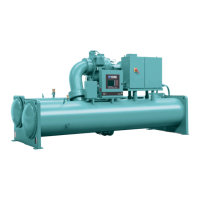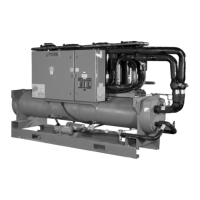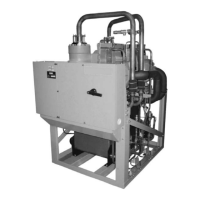Monthly (or more often as required)
• Log and compare the VSD input voltage current for balanced values in the readings.
• Verify that the unit setpoints have not been changed. Check the setpoints in the Security Log
screen.
• Verify that the evaporator and condenser water flows are within rated limits.
• Check the operation of the motor starter. Monitor at unit start-up for any abnormalities.
Annually (or more often if necessary)
1. For the evaporator and condenser, perform the following inspections:
a. Inspect and clean the water strainers.
b. Inspect and clean the tubes as required.
c. Inspect the end sheet.
2. For the compressor drive motor, measure the motor winding insulation resistance (megohm
testing).
3. Check and tighten all of the electrical components as necessary.
4. Clean and backflush the VSD heat exchanger.
5. Replace the VSD coolant.
6. Perform the UPS battery health check in the OptiView control center.
7. Perform a refrigerant analysis.
8. If the power fail landing increases by 1, a service technician must investigate the power loss
issue.
9. For all HYP model VSDs, conduct the Smart sensor annual test.
10. Review operating data for trends that indicate increasing vibration, or power consumption.
Checking system for leaks
Leak testing during operation
The refrigerant side of the system is carefully pressure tested and evacuated at the factory.
After the system has been charged, the system should be carefully leak tested with a refrigerant
compatible leak detector to be sure all joints are tight.
If any leaks are indicated, they must be repaired immediately. At times, leaks can be stopped by
ensuring face seal nuts and flange bolts are correctly torqued. However, for any major repair, the
refrigerant charge must be removed. See Handling refrigerant for dismantling and repairs.
Conduct pressure test
About this task:
With the refrigerant charge removed and all known leaks repaired, charge the system with dry
nitrogen to 150 psig to (1 MPa) detect any leaks using a liquid soap solution test. The test can be
enhanced with the use of an ultrasonic leak detector.
Optional Trace Gas Pressure Test
1. With no pressure in the system and refrigerant removed, charge a trace gas (helium may be
used) and dry nitrogen mixture into the chiller until pressure is at least 100 psig (700 kPa).
2. One method is to charge 5 to 10 lbm of the environmentally-appropriate trace gas and then
add dry nitrogen into the system to a pressure of 100 psig (700 kPa).
YMC
2
Mod B with OptiView
™
Control Center
158

